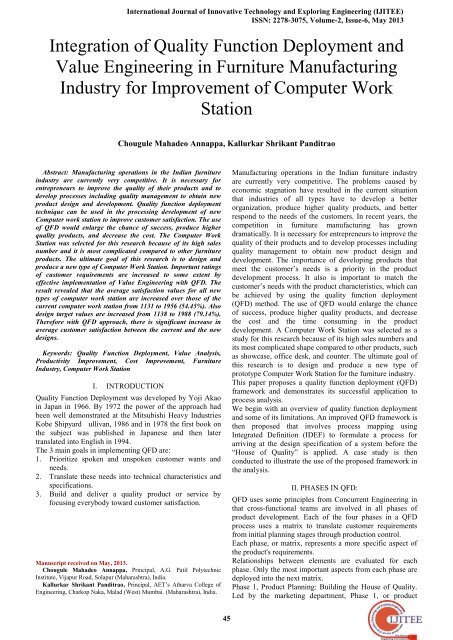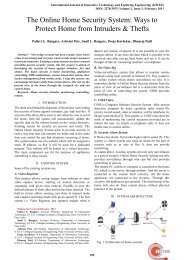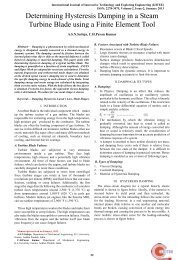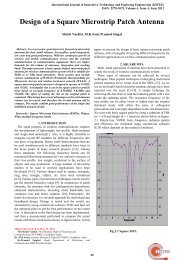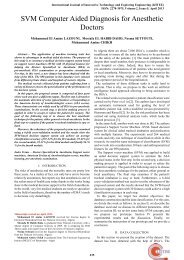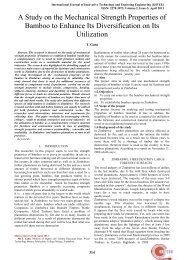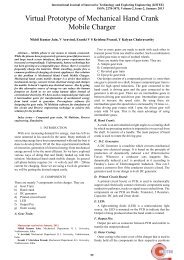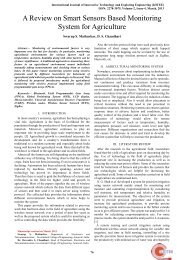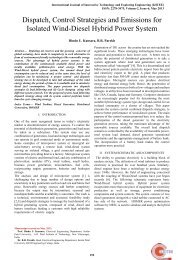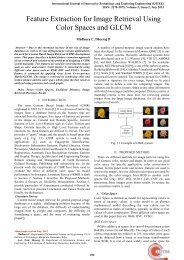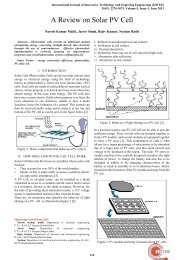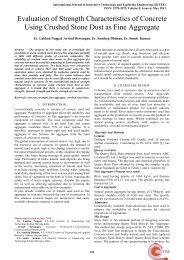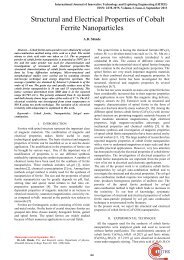Integration of Quality Function Deployment and Value Engineering ...
Integration of Quality Function Deployment and Value Engineering ...
Integration of Quality Function Deployment and Value Engineering ...
Create successful ePaper yourself
Turn your PDF publications into a flip-book with our unique Google optimized e-Paper software.
International Journal <strong>of</strong> Innovative Technology <strong>and</strong> Exploring <strong>Engineering</strong> (IJITEE)<br />
ISSN: 2278-3075, Volume-2, Issue-6, May 2013<br />
<strong>Integration</strong> <strong>of</strong> <strong>Quality</strong> <strong>Function</strong> <strong>Deployment</strong> <strong>and</strong><br />
<strong>Value</strong> <strong>Engineering</strong> in Furniture Manufacturing<br />
Industry for Improvement <strong>of</strong> Computer Work<br />
Station<br />
Chougule Mahadeo Annappa, Kallurkar Shrikant P<strong>and</strong>itrao<br />
Abstract: Manufacturing operations in the Indian furniture<br />
industry are currently very competitive. It is necessary for<br />
entrepreneurs to improve the quality <strong>of</strong> their products <strong>and</strong> to<br />
develop processes including quality management to obtain new<br />
product design <strong>and</strong> development. <strong>Quality</strong> function deployment<br />
technique can be used in the processing development <strong>of</strong> new<br />
Computer work station to improve customer satisfaction. The use<br />
<strong>of</strong> QFD would enlarge the chance <strong>of</strong> success, produce higher<br />
quality products, <strong>and</strong> decrease the cost. The Computer Work<br />
Station was selected for this research because <strong>of</strong> its high sales<br />
number <strong>and</strong> it is most complicated compared to other furniture<br />
products. The ultimate goal <strong>of</strong> this research is to design <strong>and</strong><br />
produce a new type <strong>of</strong> Computer Work Station. Important ratings<br />
<strong>of</strong> customer requirements are increased to some extent by<br />
effective implementation <strong>of</strong> <strong>Value</strong> <strong>Engineering</strong> with QFD. The<br />
result revealed that the average satisfaction values for all new<br />
types <strong>of</strong> computer work station are increased over those <strong>of</strong> the<br />
current computer work station from 1131 to 1956 (54.45%). Also<br />
design target values are increased from 1138 to 1988 (79.14%).<br />
Therefore with QFD approach, there is significant increase in<br />
average customer satisfaction between the current <strong>and</strong> the new<br />
designs.<br />
Keywords: <strong>Quality</strong> <strong>Function</strong> <strong>Deployment</strong>, <strong>Value</strong> Analysis,<br />
Productivity Improvement, Cost Improvement, Furniture<br />
Industry, Computer Work Station<br />
I. INTRODUCTION<br />
<strong>Quality</strong> <strong>Function</strong> <strong>Deployment</strong> was developed by Yoji Akao<br />
in Japan in 1966. By 1972 the power <strong>of</strong> the approach had<br />
been well demonstrated at the Mitsubishi Heavy Industries<br />
Kobe Shipyard ullivan, 1986 <strong>and</strong> in 1978 the first book on<br />
the subject was published in Japanese <strong>and</strong> then later<br />
translated into English in 1994.<br />
The 3 main goals in implementing QFD are:<br />
1. Prioritize spoken <strong>and</strong> unspoken customer wants <strong>and</strong><br />
needs.<br />
2. Translate these needs into technical characteristics <strong>and</strong><br />
specifications.<br />
3. Build <strong>and</strong> deliver a quality product or service by<br />
focusing everybody toward customer satisfaction.<br />
Manuscript received on May, 2013.<br />
Chougule Mahadeo Annappa, Principal, A.G. Patil Polytechnic<br />
Institute, Vijapur Road, Solapur (Maharashtra), India.<br />
Kallurkar Shrikant P<strong>and</strong>itrao, Principal, AET’s Atharva College <strong>of</strong><br />
<strong>Engineering</strong>, Charkop Naka, Malad (West) Mumbai. (Maharashtra), India.<br />
Manufacturing operations in the Indian furniture industry<br />
are currently very competitive. The problems caused by<br />
economic stagnation have resulted in the current situation<br />
that industries <strong>of</strong> all types have to develop a better<br />
organization, produce higher quality products, <strong>and</strong> better<br />
respond to the needs <strong>of</strong> the customers. In recent years, the<br />
competition in furniture manufacturing has grown<br />
dramatically. It is necessary for entrepreneurs to improve the<br />
quality <strong>of</strong> their products <strong>and</strong> to develop processes including<br />
quality management to obtain new product design <strong>and</strong><br />
development. The importance <strong>of</strong> developing products that<br />
meet the customer’s needs is a priority in the product<br />
development process. It also is important to match the<br />
customer’s needs with the product characteristics, which can<br />
be achieved by using the quality function deployment<br />
(QFD) method. The use <strong>of</strong> QFD would enlarge the chance<br />
<strong>of</strong> success, produce higher quality products, <strong>and</strong> decrease<br />
the cost <strong>and</strong> the time consuming in the product<br />
development. A Computer Work Station was selected as a<br />
study for this research because <strong>of</strong> its high sales numbers <strong>and</strong><br />
its most complicated shape compared to other products, such<br />
as showcase, <strong>of</strong>fice desk, <strong>and</strong> counter. The ultimate goal <strong>of</strong><br />
this research is to design <strong>and</strong> produce a new type <strong>of</strong><br />
prototype Computer Work Station for the furniture industry.<br />
This paper proposes a quality function deployment (QFD)<br />
framework <strong>and</strong> demonstrates its successful application to<br />
process analysis.<br />
We begin with an overview <strong>of</strong> quality function deployment<br />
<strong>and</strong> some <strong>of</strong> its limitations. An improved QFD framework is<br />
then proposed that involves process mapping using<br />
Integrated Definition (IDEF) to formulate a process for<br />
arriving at the design specification <strong>of</strong> a system before the<br />
“House <strong>of</strong> <strong>Quality</strong>” is applied. A case study is then<br />
conducted to illustrate the use <strong>of</strong> the proposed framework in<br />
the analysis.<br />
II. PHASES IN QFD:<br />
QFD uses some principles from Concurrent <strong>Engineering</strong> in<br />
that cross-functional teams are involved in all phases <strong>of</strong><br />
product development. Each <strong>of</strong> the four phases in a QFD<br />
process uses a matrix to translate customer requirements<br />
from initial planning stages through production control.<br />
Each phase, or matrix, represents a more specific aspect <strong>of</strong><br />
the product's requirements.<br />
Relationships between elements are evaluated for each<br />
phase. Only the most important aspects from each phase are<br />
deployed into the next matrix.<br />
Phase 1, Product Planning: Building the House <strong>of</strong> <strong>Quality</strong>.<br />
Led by the marketing department, Phase 1, or product<br />
45
<strong>Integration</strong> <strong>of</strong> <strong>Quality</strong> <strong>Function</strong> <strong>Deployment</strong> <strong>and</strong> <strong>Value</strong> <strong>Engineering</strong> in Furniture Manufacturing Industry for<br />
Improvement <strong>of</strong> Computer Work Station<br />
planning, is also called The House <strong>of</strong> <strong>Quality</strong>. Many<br />
organizations only get through this phase <strong>of</strong> a QFD process.<br />
Phase 1 documents customer requirements, warranty data,<br />
competitive opportunities, product measurements,<br />
competing product measures, <strong>and</strong> the technical ability <strong>of</strong> the<br />
organization to meet each customer requirement. Getting<br />
good data from the customer in Phase 1 is critical to the<br />
success <strong>of</strong> the entire QFD process.<br />
Phase 2, Product Design: This phase 2 is led by the<br />
engineering department. Product design requires creativity<br />
<strong>and</strong> innovative team ideas. Product concepts are created<br />
during this phase <strong>and</strong> part specifications are documented.<br />
Parts that are determined to be most important to meeting<br />
customer needs are then deployed into process planning, or<br />
Phase 3, Process Planning: Process planning comes next <strong>and</strong><br />
is led by manufacturing engineering. During process<br />
planning, manufacturing processes are flowcharted <strong>and</strong><br />
process parameters (or target values) are documented.<br />
Phase 4, Process Control: And finally, in production<br />
planning, performance indicators are created to monitor the<br />
production process, maintenance schedules, <strong>and</strong> skills<br />
training for operators. Also, in this phase decisions are made<br />
as to which process poses the most risk <strong>and</strong> controls are put<br />
in place to prevent failures. The quality assurance<br />
department in concert with manufacturing leads Phase 4.<br />
III. OVERVIEW OF QUALITY FUNCTION<br />
DEPLOYMENT (QFD)<br />
QFD is a tool for improving the development cycle <strong>and</strong><br />
manufacturing products that better match customer needs.<br />
QFD accomplishes these goals through the use <strong>of</strong> a design<br />
tool that is known as the “House <strong>of</strong> <strong>Quality</strong>” (HOQ) as<br />
shown in Figure 1. The “Whats” room represents the voice<br />
<strong>of</strong> the customer <strong>and</strong> on the right is a customer competitive<br />
assessment that is expressed in form <strong>of</strong> a rating. The<br />
“Hows” room records the functional characteristics <strong>of</strong> a<br />
product including how customer needs can be met. The ro<strong>of</strong><br />
is the correlation matrix room which indicates the positive<br />
<strong>and</strong> negative relationships between the technical<br />
characteristics <strong>of</strong> the product. These relationships can help<br />
to generate new alternatives by highlighting areas for<br />
improvement in current products. After completing the<br />
“Whats” <strong>and</strong> the “Hows” rooms, these relationships can be<br />
worked out <strong>and</strong> expressed in a relationship matrix as<br />
indicated in the center <strong>of</strong> the house. Once the relationship<br />
matrix has been completed, the extent to which the product<br />
performance will satisfy customers is calculated <strong>and</strong> is<br />
expressed as an absolute score <strong>and</strong> a score that is relative to<br />
the target value.<br />
Traditional QFD methodology has many limitations. For<br />
example, the identification <strong>of</strong> customer requirements is<br />
ambiguous <strong>and</strong> unsystematic <strong>and</strong> the functional<br />
characteristics <strong>of</strong> a complicated product cannot be easily<br />
determined. In this paper, an improved QFD framework is<br />
reported in which customer requirements are identified<br />
systemically using the “value engineering” concept.<br />
IV. QFD PROCEDURE<br />
Three main steps to carry out the house <strong>of</strong> quality (HOQ) <strong>of</strong><br />
QFD technique are described as following:<br />
Step 1: Customers’ voices collection In order to design <strong>and</strong><br />
produce the new type <strong>of</strong> computer work station <strong>and</strong> its<br />
abilities to satisfy customer needs, the customer<br />
requirements are gathered. To obtain this information, two<br />
main groups from both product users <strong>and</strong> sales agent stores<br />
were investigated. This kind <strong>of</strong> primary information, which<br />
consists <strong>of</strong> personal ideas <strong>of</strong> each customer, is not an <strong>of</strong>ficial<br />
language <strong>and</strong> hence needs to be revised for grouping <strong>and</strong><br />
resolving confusion. Analysis can be done by using different<br />
costumer requirements i.e.<br />
Strong <strong>and</strong> Durable, Suitable Size, Attractiveness, Easy to<br />
Use, <strong>Function</strong>ality, Cupboard Storage, Low Maintenance,<br />
strong Joints, Easy to H<strong>and</strong>le, <strong>Quality</strong> Material etc.<br />
Step 2: Customer requirements ranking Based on the basic<br />
data obtained from the first step, two more questionnaires<br />
were produced to convey the significance level <strong>of</strong> needs <strong>and</strong><br />
the level <strong>of</strong> satisfaction on the current computer work station<br />
<strong>of</strong> the case-study factory comparing to other similar<br />
industries. A sample is used on each questionnaire focusing<br />
on two main categories; format <strong>and</strong> material <strong>of</strong> the product<br />
as listed above in costumer requirements. The respondents<br />
were given an evaluation choice on a scale from 1 to 5, with<br />
5 being most important <strong>and</strong> 1 being less important. The<br />
geometric mean equation was used to calculate the primary<br />
data from these two questionnaires. In order to complete this<br />
task, the needs’ importance weights were multiplied by<br />
improvement ratio values, resulting in the important<br />
ranking.<br />
Step 3: Product planning matrix, or House <strong>of</strong> <strong>Quality</strong><br />
development<br />
The first matrix <strong>of</strong> the QFD method is called the House <strong>of</strong><br />
<strong>Quality</strong> which is constructed to analyze <strong>and</strong> translate the<br />
customer requirements (What’s) into technical requirements<br />
(How’s). The basic structure <strong>of</strong> the HOQ is presented in<br />
Figure 1. The building <strong>of</strong> the first HOQ consists <strong>of</strong> 6 basic<br />
sections, thus:<br />
Figure no. 1<br />
Section 1: The customer requirement <strong>and</strong> the significance<br />
level <strong>of</strong> needs are gathered from the existing needs <strong>of</strong><br />
customer. This information was identified through a survey<br />
with the first <strong>and</strong> the second questionnaire. The most<br />
mentioned items were listed as the “customer requirement”<br />
(What’s)<br />
Section 2: The levels <strong>of</strong> satisfaction <strong>of</strong> the case-study<br />
factory comparing to other similar industries, depicted on<br />
the right h<strong>and</strong> side <strong>of</strong> Figure 1 <strong>and</strong> exhibited in Figure 1,<br />
were assigned by the respondents <strong>of</strong> the third questionnaire.<br />
The goal <strong>of</strong> satisfaction level in each customer requirement<br />
was selected from the maximum value between the value <strong>of</strong><br />
the case-study factory <strong>and</strong> the other similar industries. The<br />
improvement ratio for each customer requirement can be<br />
evaluated by dividing the goal value with<br />
46
International Journal <strong>of</strong> Innovative Technology <strong>and</strong> Exploring <strong>Engineering</strong> (IJITEE)<br />
ISSN: 2278-3075, Volume-2, Issue-6, May 2013<br />
the rating <strong>of</strong> satisfaction value <strong>of</strong> the case-study factory.<br />
Lastly, the important ranking value for each customer<br />
requirement was determined by multiplying the<br />
improvement ratio with the significance level <strong>of</strong> needs.<br />
Section 3: Technical requirement (How’s) is the result <strong>of</strong><br />
group brainstorming from various sections in the factory<br />
including ownership <strong>and</strong> the management team, marketing,<br />
production, design, <strong>and</strong> delivery departments. Two<br />
classifications were categorized; format <strong>and</strong> material. A<br />
cause-effect diagram was applied to analyze the relationship<br />
<strong>of</strong> the technical requirements to meet the customer<br />
requirements As a result, the target value <strong>of</strong> the technical<br />
requirements was set to measure <strong>and</strong> determine the direction<br />
<strong>of</strong> the goal <strong>of</strong> improvement.<br />
Section 4: Rating <strong>of</strong> the relationship between the customer<br />
requirements <strong>and</strong> the technical requirements was evaluated<br />
by a group <strong>of</strong> product development team. The relationship<br />
matrix was then constructed to provide a listing <strong>of</strong> how the<br />
technical requirements represent each customer’s needs on a<br />
scale <strong>of</strong> 1, 4, <strong>and</strong> 9. The rating scale 1 represents a slight or<br />
possible relationship, 4 represents a moderate relationship,<br />
<strong>and</strong> 9 st<strong>and</strong>s for a strong relationship.<br />
Section 5: Priority relationships are composed <strong>of</strong> two<br />
sections, the significance levels <strong>of</strong> the absolute <strong>and</strong> the<br />
relative technical requirements. These are the measurement<br />
for the How’s. The use <strong>of</strong> the significance value is to<br />
determine priorities <strong>and</strong> direction for improvements <strong>of</strong> the<br />
How’s. The value <strong>of</strong> the significance level <strong>of</strong> absolute<br />
technical requirement (SL_ABS) represents the technical<br />
requirements necessary to meet the customer needs, <strong>and</strong> can<br />
be calculated by:<br />
SL _ ABS = ∑ (<strong>Value</strong> <strong>of</strong> relationship between customer<br />
requirements <strong>and</strong> Technical requirements x Important<br />
ranking value) ………………….. (1)<br />
The value <strong>of</strong> the significance level <strong>of</strong> relative technical<br />
requirements (SL_REL) can be calculated by:<br />
SL _ REL = (Significance level <strong>of</strong> absolute Technical<br />
requirement) x 100 / ∑ (Total <strong>of</strong> significance level <strong>of</strong><br />
absolute Technical requirement)<br />
…..……..(2)<br />
Section 6: The technical correlations, assigned in the ro<strong>of</strong> <strong>of</strong><br />
the HOQ, are the result <strong>of</strong> group brainstorming to determine<br />
the relationship between the “How’s” <strong>and</strong> to show what<br />
“How’s” influence each technique. These indications show<br />
that technical elements affect the performance <strong>of</strong> each<br />
other’s, which is represented by the sign “√” for a strong<br />
relationship <strong>and</strong> by “x” for a weak relationship. The<br />
application <strong>of</strong> HOQ matrix “What’s versus How’s” is<br />
presented in Figure 3.<br />
The application <strong>of</strong> HOQ matrix “What’s versus How’s”<br />
study is on the product, in this case we use furniture product,<br />
modular computer work stations. As already mentioned<br />
above there are many differences to measure the<br />
effectiveness <strong>of</strong> the modularity, modularity is measured in<br />
the research the most appropriate to the needs <strong>of</strong> consumers<br />
with the voice <strong>of</strong> the customer notice to find exactly what is<br />
needed <strong>and</strong> desired by consumers to indicate the level <strong>of</strong><br />
interest "interesting", "should be have "or" one dimensional<br />
". From the measurement <strong>of</strong> a modular approach <strong>of</strong> the<br />
seventh over, the most relevant needs <strong>and</strong> desires is a sound<br />
approach to consumer approach that is based on the first<br />
function (function based modular design). Attribute <strong>of</strong> a<br />
successful vote was unearthed from the consumer <strong>and</strong> this is<br />
developed a system module design based on sound<br />
consumer, where the needs <strong>of</strong> the product needs to search<br />
critically use <strong>Quality</strong> <strong>Function</strong> <strong>Deployment</strong> (QFD) to get<br />
any technical needs that must be present in the product. Next<br />
to find the product functions in the split components <strong>and</strong><br />
modules used method to get the FAST modules are prepared<br />
in accordance with the product functions.<br />
V. COMPUTER WORK STATION<br />
Figure no. 2<br />
The company Gayatri Industries Pvt. Ltd. is<br />
selected for case study, located in Sangli, Maharashtra in<br />
India. This company came into existence in March 2007.<br />
The major product <strong>of</strong> the company is Different types <strong>of</strong><br />
Computer work stations, Office tables, Bed, Benches,<br />
Wardrobe, Study table, TV St<strong>and</strong>, Stools etc. currently<br />
supply to local dealers in Sangli <strong>and</strong> near by area. This<br />
company is mainly focused on manufacturing as per<br />
customer’s design.<br />
Computer work stations are manufactured in<br />
different models by using different types <strong>of</strong> material. In the<br />
present case it is manufactured in steel <strong>and</strong> board. While<br />
manufacturing this computer work station we have observed<br />
that no. <strong>of</strong> cut pieces are wasted. Every component <strong>of</strong><br />
computer work station is manufactured from new board<br />
material. After analyzing the production process, it is<br />
observed that keyboard guide strip, keyboard stopper,<br />
complete drawer assembly can be manufactured from waste<br />
pieces by cutting in required size. There by which the<br />
product will be attracted to customers by cutting down the<br />
cost with maintaining good quality. Here saving in material<br />
is achieved with reduction in waste. Also existing computer<br />
work station (4’x 2’) can be modified in two types only by<br />
changing the table top to size (4.5’ x 2.5’ <strong>and</strong> 5’ x 3’) where<br />
maintaining the bottom structure as it is. By this variety <strong>of</strong><br />
computer work station can be increased up to 3 <strong>and</strong><br />
customer has choice according to their spare available <strong>and</strong><br />
multi-functionality. This can be used as Office Table cum<br />
Computer Work Station.<br />
47
<strong>Integration</strong> <strong>of</strong> <strong>Quality</strong> <strong>Function</strong> <strong>Deployment</strong> <strong>and</strong> <strong>Value</strong> <strong>Engineering</strong> in Furniture Manufacturing Industry for<br />
Improvement <strong>of</strong> Computer Work Station<br />
Figure no. 3<br />
48
International Journal <strong>of</strong> Innovative Technology <strong>and</strong> Exploring <strong>Engineering</strong> (IJITEE)<br />
ISSN: 2278-3075, Volume-2, Issue-6, May 2013<br />
Figure no. 4<br />
VI. RESULTS AND DISCUSSION<br />
The QFD technique was applied to design <strong>and</strong> produce the<br />
new type <strong>of</strong> Steel Computer work station. The result <strong>of</strong> the<br />
QFD technique takes note <strong>of</strong> the furniture characteristics<br />
that the customer’s desire. For example, the most important<br />
requirements were indicated depending on the highest value<br />
<strong>of</strong> the significant <strong>of</strong> relative technical requirement. These<br />
parameters include the weight, size, number <strong>of</strong> color,<br />
number <strong>of</strong> assembly part, board quality, strength, hardware<br />
quality, multi functionality, durability <strong>of</strong> material <strong>and</strong> color<br />
etc.<br />
49
<strong>Integration</strong> <strong>of</strong> <strong>Quality</strong> <strong>Function</strong> <strong>Deployment</strong> <strong>and</strong> <strong>Value</strong> <strong>Engineering</strong> in Furniture Manufacturing Industry for<br />
Improvement <strong>of</strong> Computer Work Station<br />
It can be seen that these technical requirements (How’s)<br />
were highly related to the various customer requirements<br />
<strong>and</strong> would have a high impact to increase the satisfaction<br />
value <strong>of</strong> the Computer work station. The product was<br />
therefore designed <strong>and</strong> manufactured based on the important<br />
requirements, particularly on the above discussed<br />
parameters. To determine customer satisfaction <strong>of</strong> the new<br />
prototype <strong>of</strong> computer work station over the current one, the<br />
evaluations were therefore arranged through pictures <strong>and</strong><br />
product descriptions<br />
However, the pictures before <strong>and</strong> after the improvement<br />
were very carefully taken in order to cover the information<br />
needed, <strong>and</strong> the associated features were thoroughly<br />
described in order to ease the rating determination. Graph<br />
no. 1 shows comparisons <strong>of</strong> the average values <strong>of</strong> customer<br />
satisfaction for 18 <strong>of</strong> the 26 customers’ needs; the other 8<br />
criteria above being neglected. The average total satisfaction<br />
value for the new product increased over the current product<br />
by about 54.45%, as calculated <strong>and</strong> shown in Table 1. Also<br />
average value <strong>of</strong> absolute importance design target <strong>of</strong><br />
computer work station for 14 <strong>of</strong> the 21design requirements;<br />
the other seven criteria being neglected. The average total<br />
absolute importance design target value for the new product<br />
increased over the current product by 79.14 % as calculated<br />
<strong>and</strong> shown in Table no. 2. It is clearly found that customer<br />
appreciated the improvements in every item/part <strong>of</strong> the new<br />
product. This highlights the effect <strong>of</strong> new product features<br />
that better meet customer dem<strong>and</strong>s, leading to an increase in<br />
customer satisfaction. The result is one other supportive<br />
evidence that QFD analysis can yield some useful<br />
information what product properties are important when it<br />
comes to meet the customer dem<strong>and</strong>s.<br />
After analyzing the QFD for furniture manufacturing<br />
industry for current type, it is observed that Important<br />
ratings <strong>of</strong> customer requirements is less as compare with<br />
new type as far as the design (Tech.) requirements are<br />
concerned. These are increased to some extent by effective<br />
implementation <strong>of</strong> <strong>Value</strong> <strong>Engineering</strong> with QFD.<br />
Also no. <strong>of</strong> factors e.g. strong joints, easy to h<strong>and</strong>le, wide<br />
drawer, pen holder, level adjustment are considered in new<br />
type QFD which are not in current QFD <strong>and</strong> also customer<br />
requirements related to material i.e. st<strong>and</strong>ardize material,<br />
<strong>Quality</strong> board, Ease <strong>of</strong> cleaning are considered in new QFD<br />
which are also not in current QFD. The result revealed that<br />
the average satisfaction values for all new types <strong>of</strong> computer<br />
work station increased over those <strong>of</strong> the current computer<br />
work station from 1131 to 1956 (54.45%). Also design<br />
target values are also increase from 1138 to 1988 (79.14%).<br />
Hypothesis testing <strong>of</strong> satisfaction<br />
To compare customer satisfaction before <strong>and</strong> after applying<br />
QFD technique, the percentage change values out <strong>of</strong> 26<br />
customer requirements (what’s) were considered for study<br />
(see Table no. 1). The average customer satisfaction values<br />
showed that the attractiveness <strong>of</strong> part gave the highest<br />
(111.11%) <strong>and</strong> the lowest for Suitable weight (12.5%)<br />
values. The average customer satisfaction <strong>of</strong> the new design<br />
(1956) is higher than that <strong>of</strong> the current design (1131) for 26<br />
types <strong>of</strong> customers need.<br />
The result reveals that the average customer satisfaction<br />
regarding the new design <strong>of</strong> each feature increased<br />
significantly, based on the QFD approach. Therefore, it can<br />
be claimed that other features, which have a higher<br />
percentage change value <strong>of</strong> customer satisfaction would also<br />
be significantly acceptable. Therefore with QFD approach,<br />
we found that there is significant increase in average<br />
customers satisfaction between the current <strong>and</strong> the new<br />
designs<br />
Table No. 1 Customers Satisfaction Performance<br />
Customers Needs Current Design New Design % Change<br />
Strong & Durable X1 151 200 32.45<br />
Easy to Assemble X2 49 68 38.77<br />
Easy to Move X3 20 20 0<br />
Suitable weight X4 32 68 12.5<br />
Suitable size X5 132 105 -20.46<br />
Attractiveness X6 81 183 111.11<br />
Easy to use X7 72 72 0<br />
<strong>Function</strong>ality X8 27 54 100<br />
Mobil Drawer X9 0 12 100<br />
Cupboard Storage X10 27 27 0<br />
Individual Lock X11 0 12 100<br />
Separate location for parts X12 65 65 0<br />
Warranty X13 0 0 0<br />
Low Maintenance X14 108 144 33.33<br />
Strong Joint X15 0 36 100<br />
Easy to H<strong>and</strong>le X16 0 54 100<br />
Wide Drawer X17 0 36 100<br />
Pen Holder X18 0 12 100<br />
Level Adjustment X19 0 0 0<br />
50
International Journal <strong>of</strong> Innovative Technology <strong>and</strong> Exploring <strong>Engineering</strong> (IJITEE)<br />
ISSN: 2278-3075, Volume-2, Issue-6, May 2013<br />
<strong>Quality</strong> Material X20 135 180 33.33<br />
<strong>Quality</strong> Hardware X21 88 124 40.9<br />
Material Safety X22 36 36 0<br />
Correct Thick Board X23 108 135 25<br />
St<strong>and</strong>ardize Material X24 0 36 100<br />
<strong>Quality</strong> Material X25 0 225 100<br />
Ease <strong>of</strong> Cleaning X26 0 52 100<br />
Total 1131 1956 --<br />
Average 43.5 75.23 54.45<br />
250<br />
200<br />
Current Design<br />
New Design<br />
150<br />
100<br />
50<br />
0<br />
X1 X2 X3 X4 X5 X6 X7 X8 X9 X10X11X12X13X14X15X16X17X18X19X20X21X22X23X24X25X26<br />
Graph no. 1 Average Customers Satisfaction <strong>of</strong> Computer work station before & after Improvement<br />
Table No. 2 Absolute Importance Design Target<br />
Customers Needs Current Design New Design % Change<br />
100 % Good <strong>Quality</strong> X1 155 225 45.16<br />
Suitable weight with size X2 16 16 0<br />
Table Size 4’ x 2’ & 4.5’ x 2.5’ same frame X3 27 43 59.25<br />
More than two color X4 27 27 0<br />
Able to carry max 100 Kg X5 47 128 172.34<br />
All movable parts can easily use X6 234 341 45.72<br />
can use more than one function X7 60 134 123.33<br />
No. <strong>of</strong> assemble parts > 15 X8 16 16 0<br />
Use <strong>of</strong> modern latest material X9 145 210 44.82<br />
Material will be durable for min 5 Yrs. X10 144 144 0<br />
Color will not pale within 3 Yrs. X11 27 27 0<br />
100% good quality X12 153 246 60.78<br />
More than 2 model in same / different size X13 12 43 258.33<br />
Rectangular with curved corner X14 54 39 -27.77<br />
Competitive cost X15 16 16 0<br />
Can select various color & size X16 5 24 380<br />
Bright <strong>and</strong> Appealing X17 0 72 100<br />
Supplier have high st<strong>and</strong>ard & certification X18 0 117 100<br />
Surface <strong>of</strong> material must be smooth X19 0 36 100<br />
Corner curved (No sharp corners) X20 0 12 100<br />
As per Requirements X21 0 72 100<br />
Total 1138 1988 --<br />
Average 54.19 82.83 79.14<br />
51
<strong>Integration</strong> <strong>of</strong> <strong>Quality</strong> <strong>Function</strong> <strong>Deployment</strong> <strong>and</strong> <strong>Value</strong> <strong>Engineering</strong> in Furniture Manufacturing Industry for<br />
Improvement <strong>of</strong> Computer Work Station<br />
400<br />
350<br />
300<br />
Current Design<br />
New Design<br />
250<br />
200<br />
150<br />
100<br />
50<br />
0<br />
X1 X2 X3 X4 X5 X6 X7 X8 X9 X10 X11 X12 X13 X14 X15 X16 X17 X18 X19 X20 X21<br />
Graph no. 2 Average Absolute Importance Design Target <strong>of</strong> Computer work station before & after Improvement<br />
VII. CONCLUSION<br />
<strong>Quality</strong> function deployment technique can be used in the<br />
processing development <strong>of</strong> new Computer work station to<br />
improve customer satisfaction. Customer requirements were<br />
transformed into the House <strong>of</strong> <strong>Quality</strong>. The newly designed<br />
<strong>and</strong> developed products varied in durability, assembly,<br />
attractiveness, Additional Features, shape, Size, Ease <strong>of</strong><br />
cleaning, functionality <strong>and</strong> quality <strong>of</strong> the materials. The<br />
product satisfaction was evaluated by customers comprising<br />
<strong>of</strong> groups <strong>of</strong> product users, retailers <strong>and</strong> wholesalers. The<br />
results revealed that the average satisfaction values for all<br />
new types <strong>of</strong> products increased over those <strong>of</strong> the current<br />
products, from a level <strong>of</strong> 1131 to 1956 (54.45%) as shown in<br />
graph no. 1. Similarly absolute importance <strong>of</strong> design target<br />
for new design is increased over those <strong>of</strong> current design<br />
from a level <strong>of</strong> 1138 to 1988 (79.14%) as shown in graph<br />
no. 2. Hypothesis testing <strong>of</strong> the average customer<br />
satisfaction between the current <strong>and</strong> the new designs was<br />
found to significantly increase with regard to the QFD<br />
approach.<br />
[10] Marvin e. Gonzalez, Gioconda Quesada <strong>and</strong> Terry bahill, Improving<br />
product design using quality function deployment: the school<br />
Furniture case in developing countries.<br />
[11] K. Yegenegi , m.Arastim Mousakhani, The integration <strong>of</strong> QFD<br />
technique <strong>and</strong> value engineering <strong>and</strong> its Applying in a healthcare<br />
center<br />
[12] R.umesh sundar, G. mohan kumar, Application <strong>of</strong> quality function<br />
deployment method <strong>and</strong> fuzzy logic for improving the design<br />
characteristics in FRP cooling tower-case study.<br />
REFERENCES<br />
[1] Chatree Homkhiew, Thanate Ratanawilai <strong>and</strong> Klangduen Pochana,<br />
Application <strong>of</strong> a quality function deployment technique to design<br />
<strong>and</strong> develop furniture products.<br />
[2] Yunia dwie, nurcahyanie moses <strong>and</strong> Singgih budi santosa, <strong>Quality</strong><br />
function deployment by creative industries research institute.<br />
[3] Ignacio cariaga, tamer el-diraby <strong>and</strong> hesham osman Integrating<br />
value analysis <strong>and</strong> quality function deployment for evaluating design<br />
alternatives.<br />
[4] Davood Gharakhani <strong>and</strong> Javad Eslami, Determining customer needs<br />
priorities for improving service quality using QFD<br />
[5] Sivadas aniyan t.s. promod v.r., <strong>Quality</strong> function deployment in<br />
manufacturing industry (improving the Existing sb cnc 40/60 slant<br />
bed turning centre in hmt, kalamassery).<br />
[6] Irem dikmen, Talat birgonul <strong>and</strong> semiha kiziltas, Strategic use <strong>of</strong><br />
quality function deployment (QFD) in the Construction industry<br />
[7] Robin Rawlings-Quinn,<strong>Quality</strong> function deployment (QFD): a case<br />
study<br />
[8] Chee-cheng chen, Application <strong>of</strong> quality function deployment in the<br />
semiconductor industry: A case study<br />
[9] Jim Diemsey, QFD to direct value engineering in design <strong>of</strong> brake<br />
52


